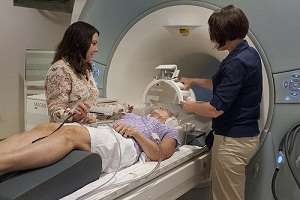Two hundred participants, including those with early signs of dementia and those diagnosed with Alzheimer’s, were assessed with neuropsychological examination, MRI, and PET scans. Credit: Penn State
Scientists from Western Australia and across the nation have shown the accumulation of a protein in the brain occurs 20 years before symptoms of Alzheimer's occur, in a groundbreaking study that could prove beneficial for early intervention.
Researchers from the Australian Imaging Biomarkers and Lifestyle (AIBL) research group describe the protein Amyloid-Beta (A?) as naturally occurring in the blood and brain. These proteins aggregate to form plaques preceding the onset of Alzheimer's disease.
AIBL's Dr Samantha Burnham says this study is the first time the time-course of A? in the onset of dementia has been quantified statistically.
"There is a general consensus that one of the first things to happen during the onset of Alzheimer's is the accumulation of this plaque in the brain. However we have never known how long before the onset of disease this happens," she says.
"Our objective with this study was to say, if we have identified someone who has reached a certain threshold of A? in the brain, how long do they have before symptoms of dementia occur?"
The study involved 200 participants, including 36 with early signs of dementia and 19 already diagnosed with Alzheimer's disease. Participants were assessed every 18 months for almost four years, with neuropsychological examination, MRI, and a PET scan.
At baseline, significantly higher levels of A? were found in patients with AD and those with mild cognitive impairment than in the healthy participants.
"I was tasked with how we could take four year follow-ups from individuals at different stages of the disease and piece them together to give an understanding of what happens throughout the course of the disease," Dr Burnham says.
"All of those individual four year trajectories had to be complied together to get an overall disease level trajectory."
During the follow-ups, 82 per cent of participants showed positive rates of A? accumulation, with deposition estimated to take 19.2 years to reach the levels observed in Alzheimer's disease.
As participants began to show symptoms of AD, the rate of A? deposition slowed towards a plateau.
"There isn't currently any clear explanation for why the accumulation of amyloid beta occurs or why it aggregates and becomes a solid plaque. We just don't know at this stage," Dr Burnham says.
Dr Burnham says the predictions of the rate of preclinical changes and the onset of the clinical phase of AD will facilitate the design and timing of therapeutic interventions aimed at modifying the course of this illness.
"What that means is that we actually have quite a large window for medical interventions to slow the disease," she says.
Provided by Science Network WA






















